Suppose you work for an organization or corporation. At least once in your professional life, you might experience a lack of leadership or direction (unless you’re very lucky).
The problem with a lack of guidance is that when we can’t see the big picture or understand the value of our work, we feel demotivated, frustrated, and eventually leave. That’s why many companies use the OKR (Objectives and Key Results) methodology to ensure everyone knows what they should be working on and feels a sense of accomplishment besides working towards the same goal.
One great example is Google, which adopted the OKR methodology as a core practice to their management and work culture. And even though the tech giant popularized this framework, the OKR methodology was created by Andrew Grove, the man behind Silicon Valley’s growth and former Intel CEO. As you can imagine, it didn’t take long for most organizations to use the OKR methodology, including Microsoft, Twitter, and Tesla.
Sarah Luisa Santos is a content writer, passionate about technology and how it helps us lead better lives. When she is not writing about Miro’s newest features and templates, she is volunteering in feminist projects helping women in the global south.
But wait, what’s an OKR?
Think of OKRs as a vehicle to turn a company’s missions into bite-size pieces of action; when combined, they show the destination where your organization wants to go.
Many leaders share their vision beautifully but often fail in articulating ways to get there. That’s what OKRs are about, a way to communicate how to achieve your objectives with actionable points.
The OKR methodology is divided into two parts: Objective and Key Results.
The Objective is the what; it’s the thing you are setting your team to do.
The Key Result is the how; it’s how you are getting there, the measurable benchmark, and milestones.
What’s unique about OKRs is the way it ties an action to something measurable. It’s easy to move forward and to keep the big picture in mind while doing it. That’s why many leaders find it helpful to know how to set OKRs with their teams, so everyone knows which direction the organization is going and their role in making that happen.
In this article, you will see how to do your OKR planning with Miro and easily apply the methodology in your organization.
Keep reading to know more about OKR planning with the Miro Smart Meetings template.
How to Facilitate an OKR Planning Workshop
OKR planning should make your team’s life easier. However, setting them for the first time requires some work, but fret not! After the first OKR planning session, it gets easier each time, and soon enough, you won’t even imagine working without them.
Below you can see a step-by-step OKR framework so that you can lead an OKR workshop seamlessly with the Miro OKR planning template.
1. Connect your team with the Love Bomb Icebreaker
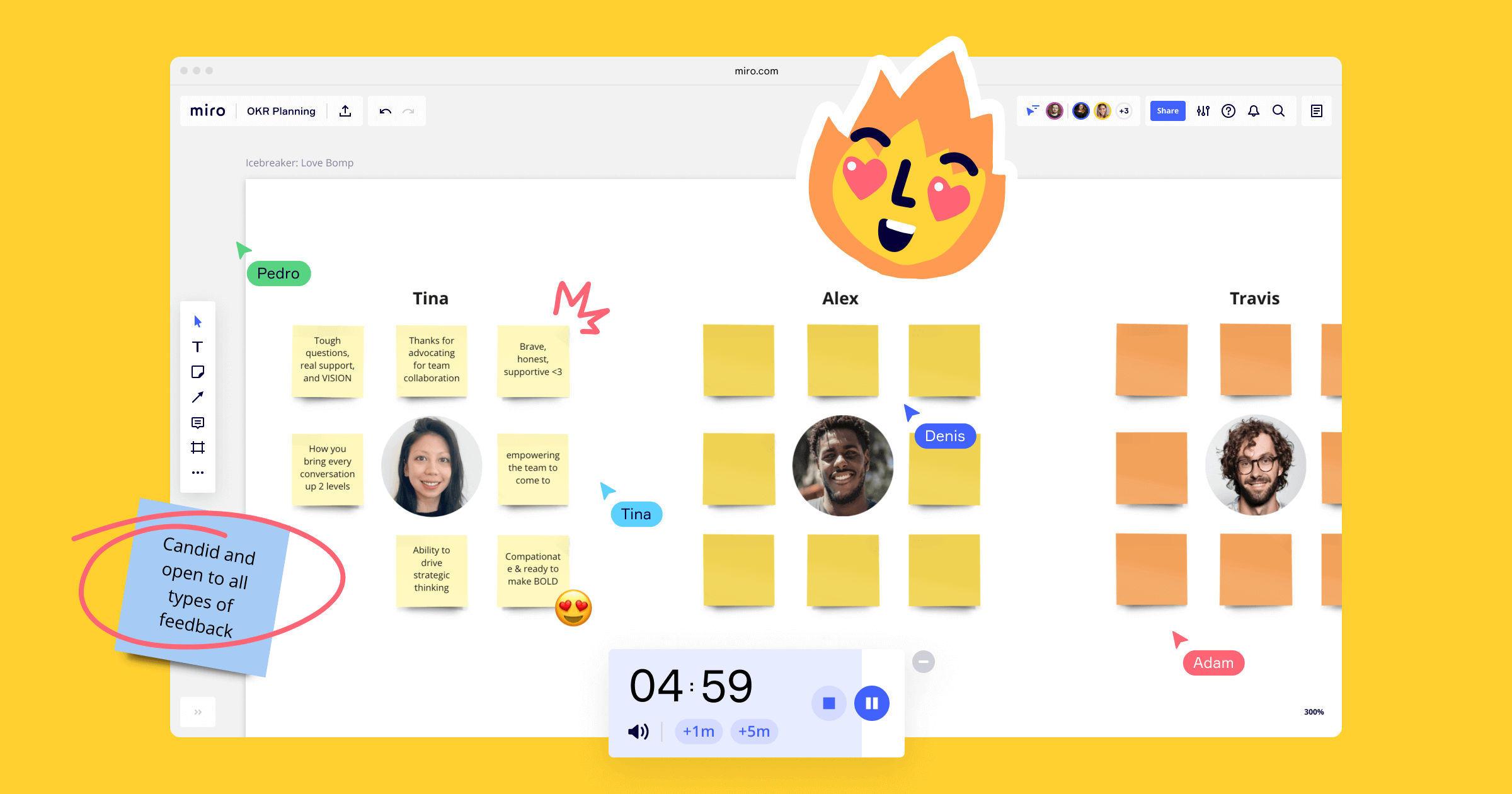
We love Icebreaker exercises! To run engaging meetings, first, get your team relaxed and acclimatized to the whiteboard. The Love Bomb Icebreaker activity is a great way to elevate your team’s morale and an opportunity for people to show appreciation for one another. This exercise consists of getting everyone to compliment each other and show them their best qualities at work.
Do: Set a timer and play some music to get people energized.
Don’t: Push team members to share or write things if they don’t feel comfortable.
2. Setting goals and topics
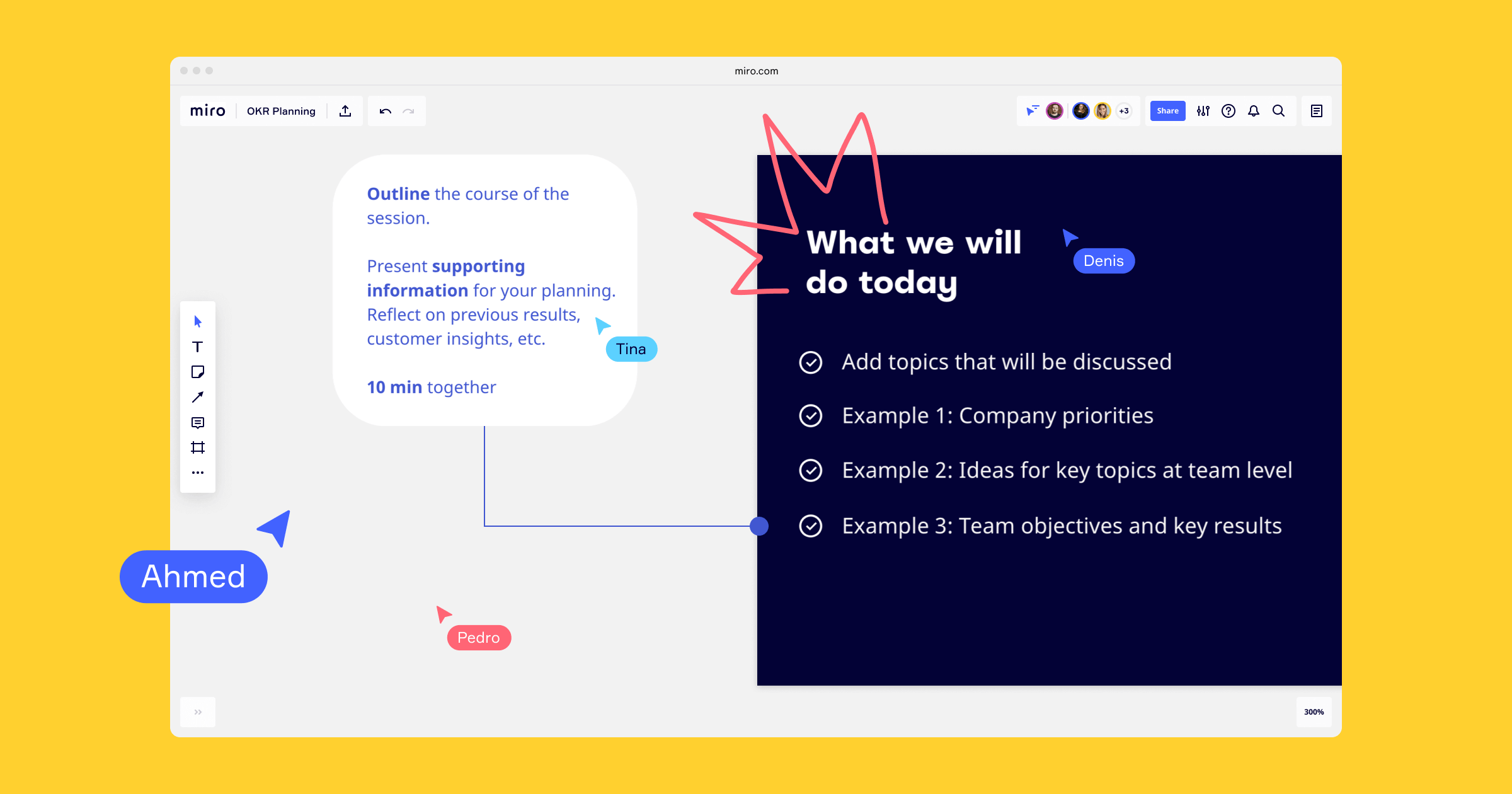
After everyone is warmed up, it’s time to present the outline of the OKR session.
Explain what everyone will do and add supporting materials to get your point across. The more visual you can be, the better. Add some statistics about last quarter’s OKRs, insights, or other information to help people reflect when planning their OKR for the next period.
Do: Use Miro’s board resources to make your presentation more visual. Add shapes, colors, and images when highlighting why OKRs are necessary.
Don’t: Throw numbers in your presentation without context or write long paragraphs.
3. Questions and answers

Set time for people to reflect on what you just presented and allow them to ask questions. Practice active listening and address any concerns and pain points assertively and with empathy.
Do: Propose questions yourself and start a discussion to identify what could be missing.
Don’t: Dismiss doubts or leave questions unanswered.
4. Brainwriting: Identify strategic topics
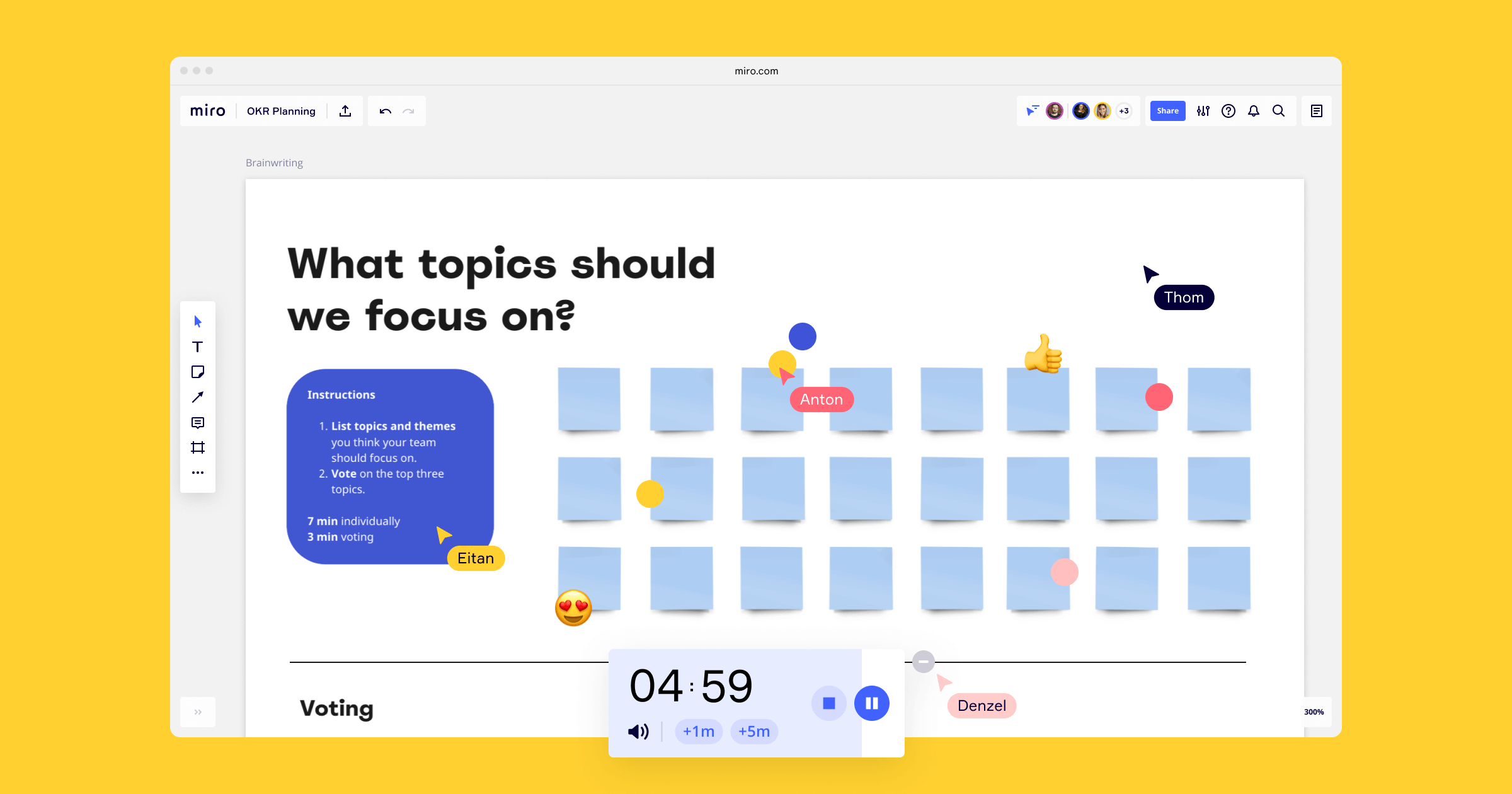
Let the fun begin! Brainwriting is similar to brainstorming, but you will get everyone to write their ideas instead of sharing them verbally.
Ask everyone to list topics they think they should focus on for the next period. This activity will help everyone see what might be on the team’s radar—afterward, do a voting session to see which topics your team wants to prioritize.
Do: Give your team room to breathe and ideate as many topics as they like.
Don’t: Get lost with many ideas. Select the 3-5 to work on in the following step.
5. Co-create OKRs in breakout groups
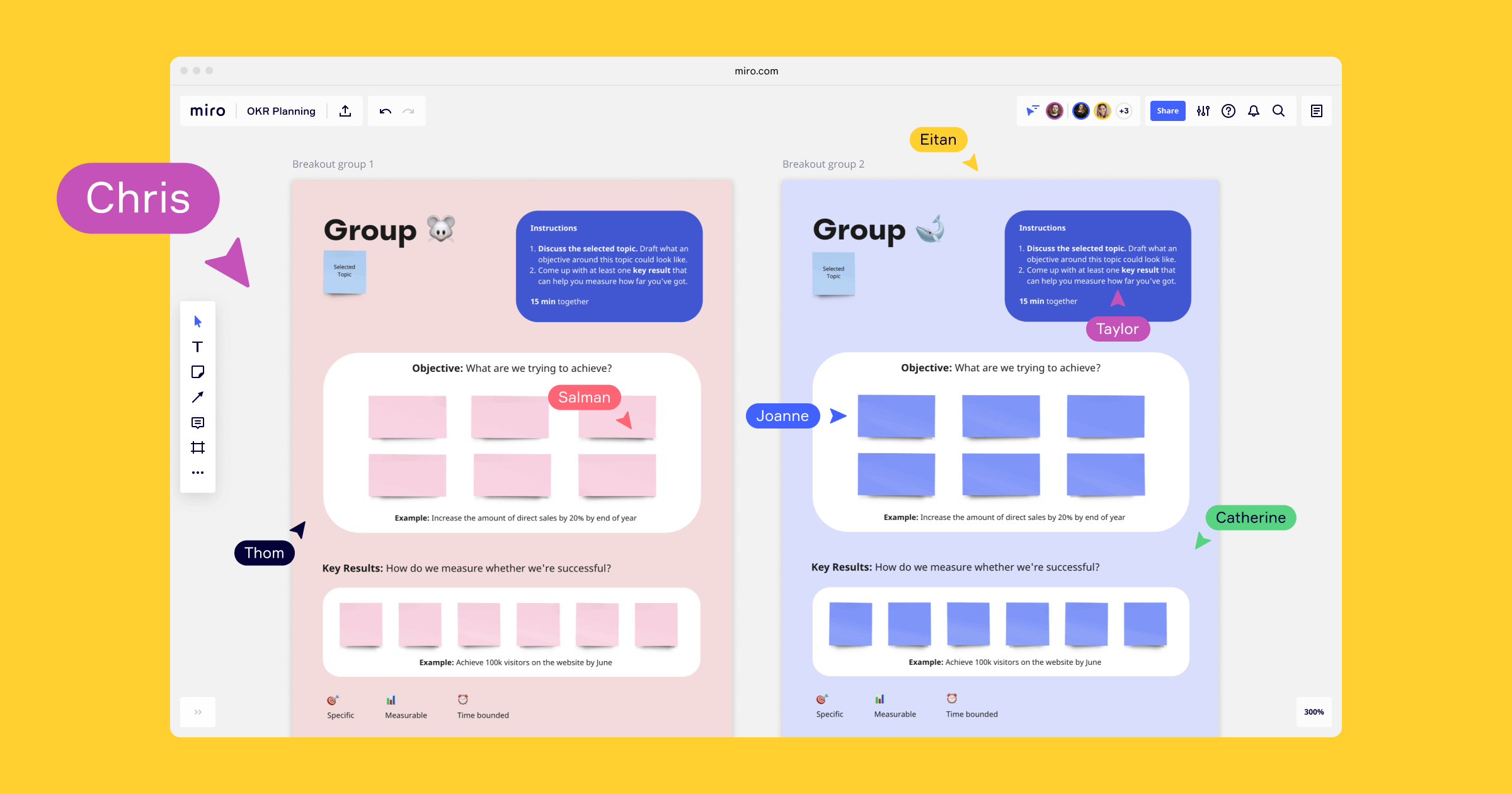
Time to define your OKRs. If you have a big team, breakout into multiple groups. Each group can discuss one of the topics chosen in the previous step and write the Objective (what are you trying to achieve) and the Key Result (how do you measure success).
Do: List questions that might come up with stickies next to the OKRs.
Don’t: Forget to set the timer and get people back at the right time.
6. Plan the future and the next steps
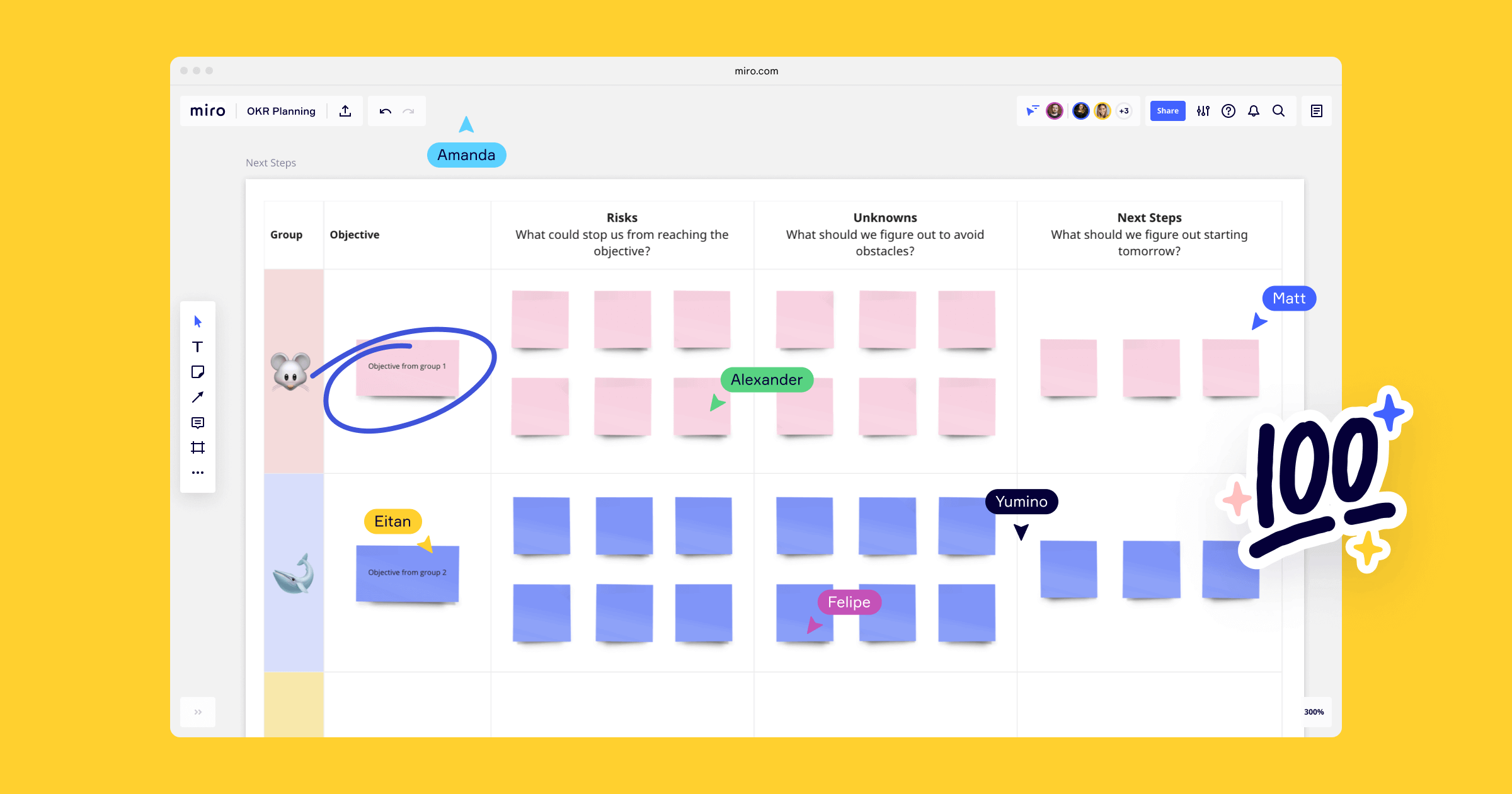
Last but not least, plan the next steps and map out the risks and obstacles to achieve them. Each group from the previous step should have at least one OKR. If you are a small team, you will all have the same OKRs. Everyone must know which OKR they will be working on in the next month or quarter.
Do: Share the board link so people can come back to it whenever necessary.
Don’t: Let too much time pass between your OKR planning and your follow-up email/meeting.
OKR action plan: How to follow-up?
Remember that OKRs describe your priorities and projects for the next month or quarter, and even though they might seem difficult to achieve or even beyond performance, it’s because they also represent the fundamental changes and growth the organization is aiming to have. Think of OKRs as your organization’s dream destination and the map to get there.
To follow up on your OKR action plan, set some time to check in regularly with your team and track progress and actions. Your OKR check-in meetings can be done once a month or bi-weekly to keep track of where you are and what it takes to get where you want to be.
Extra tips on how to get everyone accountable:
- Create a safe space where people feel comfortable sharing their concerns. Verbalize it to your team.
- Establish clear commitments, guidelines, and responsibilities, make sure everyone has a clear understanding of what is expected.
- Failures and mistakes will happen, and that’s ok. In the same way that we share successes, we should also share how we can learn and grow from setbacks.
To sum it up, OKRs are a great way to keep track of projects and to add meaning to your tasks and actions at work. Use our OKR Planning Template from Miro Smart Meetings to facilitate your OKR workshop. Follow the steps inside the template and remember our tips from this article. And if you feel great about your work, share your board in Miroverse! We’d love to hear how it worked out for you.






